In this tutorial, we show how to make a crawler in Amazon Glue.
A fully managed service from Amazon, AWS Glue handles data operations like ETL (extract, transform, load) to get the data prepared and loaded for analytics activities. Glue can crawl S3, DynamoDB, and JDBC data sources.
What is a crawler?
A crawler is a job defined in Amazon Glue. It crawls databases and buckets in S3 and then creates tables in Amazon Glue together with their schema.
Then, you can perform your data operations in Glue, like ETL.
Sample data
We need some sample data. Because we want to show how to join data in Glue, we need to have two data sets that have a common element.
The data we use is from IMDB. We have selected a small subset (24 records) of that data and put it into JSON format. (Specifically, they have been formatted to load into DynamoDB, which we will do later.)
One file has the description of a movie or TV series. The other has ratings on that series or movie. Since the data is in two files, it is necessary to join that data in order to get ratings by title. Glue can do that.
Download these two JSON data files:
wget https://raw.githubusercontent.com/werowe/dynamodb/master/100.basics.json wget https://raw.githubusercontent.com/werowe/dynamodb/master/100.ratings.tsv.json
Upload the data to Amazon S3
Create these buckets in S3 using the Amazon AWS command line client. (Don’t forget to run aws configure to store your private key and secret on your computer so you can access Amazon AWS.)
Below we create the buckets titles and rating inside movieswalker. The reason for this is Glue will create a separate table schema if we put that data in separate buckets.
(Your top-level bucket name must be unique across all of Amazon. That’s an Amazon requirement, since you refer to the bucket by URL. No two customers can have the same URL.)
aws s3 mb s3://movieswalker aws s3 mb s3://movieswalker/titles aws s3 mb s3://movieswalker/ratings
Then copy the title basics and ratings file to their respective buckets.
aws s3 cp 100.basics.json s3://movieswalker/titles aws s3 cp 100.ratings.tsv.json s3://movieswalker/ratings
Configure the crawler in Glue
Log into the Glue console for your AWS region. (Mine is European West.)
Then go to the crawler screen and add a crawler:
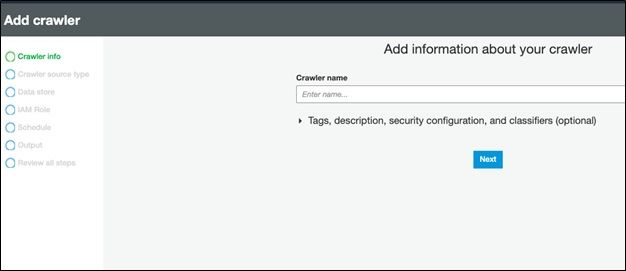
Next, pick a data store. A better name would be data source, since we are pulling data from there and storing it in Glue.
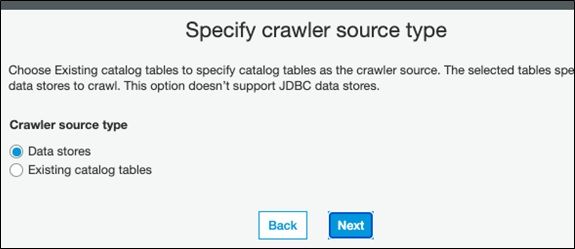
Then pick the top-level movieswalker folder we created above.
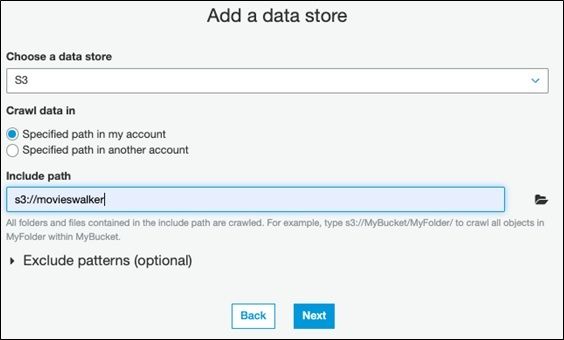
Notice that the data store can be S3, DynamoDB, or JDBC.

Then start the crawler. When it’s done you can look at the logs.
If you get this error it’s an S3 policy error. You can make the tables public just for purposes of this tutorial if you don’t want to dig into IAM policies. In this case, I got this error because I uploaded the files as the Amazon root user while I tried to access it using a user created with IAM.
ERROR : Error Access Denied (Service: Amazon S3; Status Code: 403; Error Code: AccessDenied; Request ID: 16BA170244C85551; S3 Extended Request ID: y/JBUpMqsdtf/vnugyFZp8k/DK2cr2hldoXP2JY19NkD39xiTEFp/R8M+UkdO5X1SjrYXuJOnXA=) retrieving file at s3://movieswalker/100.basics.json. Tables created did not infer schemas from this file.
View the crawler log. Here you can see each step of the process.

View tables created in Glue
Here are the tables created in Glue.
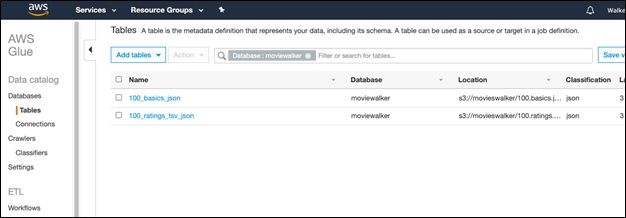
If you click on them you can see the schema.
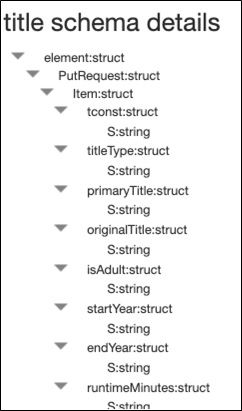
It has these properties. The item of interest to note here is it stored the data in Hive format, meaning it must be using Hadoop to store that.
{
"StorageDescriptor": {
"cols": {
"FieldSchema": [
{
"name": "title",
"type": "array<struct<PutRequest:struct<Item:struct<tconst:struct,titleType:struct,primaryTitle:struct,originalTitle:struct,isAdult:struct,startYear:struct,endYear:struct,runtimeMinutes:struct,genres:struct>>>>",
"comment": ""
}
]
},
"location": "s3://movieswalker/100.basics.json",
"inputFormat": "org.apache.hadoop.mapred.TextInputFormat",
"outputFormat": "org.apache.hadoop.hive.ql.io.HiveIgnoreKeyTextOutputFormat",
"compressed": "false",
"numBuckets": "-1",
"SerDeInfo": {
"name": "",
"serializationLib": "org.openx.data.jsonserde.JsonSerDe",
"parameters": {
"paths": "title"
}
},
"bucketCols": [],
"sortCols": [],
"parameters": {
"sizeKey": "7120",
"UPDATED_BY_CRAWLER": "S3 Movies",
"CrawlerSchemaSerializerVersion": "1.0",
"recordCount": "1",
"averageRecordSize": "7120",
"CrawlerSchemaDeserializerVersion": "1.0",
"compressionType": "none",
"classification": "json",
"typeOfData": "file"
},
"SkewedInfo": {},
"storedAsSubDirectories": "false"
},
"parameters": {
"sizeKey": "7120",
"UPDATED_BY_CRAWLER": "S3 Movies",
"CrawlerSchemaSerializerVersion": "1.0",
"recordCount": "1",
"averageRecordSize": "7120",
"CrawlerSchemaDeserializerVersion": "1.0",
"compressionType": "none",
"classification": "json",
"typeOfData": "file"
}
}
Additional resources
For more on this topic, explore these resources:
- BMC Machine Learning & Big Data Blog
- BMC Multi-Cloud Blog
- Our multi-part AWS Guide
- Is ETL (Extract, Transform, Load) Still Relevant?
- Using Python for Big Data and Analytics
- Simplifying and Scaling Data Pipelines in the Cloud
- Structured vs Unstructured Data: A Shift in Privacy






